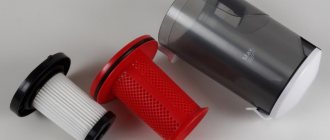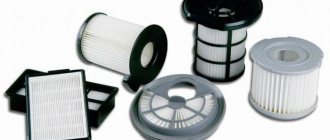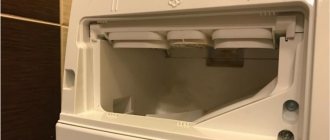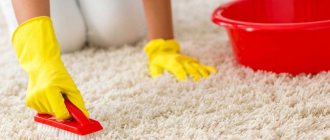Vacuum cleaners, like any other household appliances, require systematic care and timely cleaning from dirt. If you notice that the device has become worse, sucks in dust less or produces an unpleasant odor, it’s time to think about cleaning it. In this article, we will look at different cleaning methods for the main types of vacuum cleaners.
Basic rules for safe cleaning of vacuum cleaners:
- Remember to unplug the device before cleaning.
- It is better to do cleaning not in a living room, but on the street, in the garage or on an open balcony.
- Do not clean the vacuum cleaner on stairwells, under neighbors' windows, or in cramped courtyards of multi-story buildings. If your neighbors have a weakened nervous system, then such cleaning may be unsafe for your health.
Cleaning a vacuum cleaner with a dust bag
Open the device and remove the trash bag. Disconnect the hose, remove the telescopic tube, remove the filters, and clean the working hole. Use a small brush to clean dusty grates, crevices, and other hard-to-reach areas. Wipe the cavity of the vacuum cleaner with a damp cloth and leave it open to dry.
If the vacuum cleaner is significantly dirty, then after drying, blow it with clean air. To do this, take the device to the balcony, garage or street and turn it on at full power without filters, hose and nozzles. Let it work for a few minutes. If dirt has accumulated in the engine compartment, it will fly out.
Soak the plastic hose in warm soapy water, and after a while rinse it with running water, stretching the accordion so that the water washes away the dirt that has accumulated in the folds. Also clean the telescopic tube and attachments. The carpet brush needs to be disassembled, cleaned of accumulated debris and washed.
Types of dust bags
The dust collector is a consumable item. It has to be replaced regularly. There are two types of collectors to choose from.
- Disposable. Once filled, they are immediately replaced with new ones. Sharp objects can damage the drive and cause premature failure. If you choose such a garbage collector, then it is better to have a few pieces in reserve.
- Reusable fabric. They last one and a half or two times longer. The debris is simply shaken out, and the dust collector is reinstalled in the device. You can make such bags yourself.
What to do with dust bags
There are two types of dust bags. Synthetic reusable bags are made from multilayer polymer materials. Collected dust should be shaken out as it accumulates and the bag should be washed. Some manufacturers do not recommend getting fabric filters wet. But in this case, after some time, the bag will begin to emit an unpleasant odor, so it is recommended to carefully rinse fabric synthetic dust collectors at least once every three to four cleanings. To wash a reusable fabric bag, soak it in warm, soapy water and leave for about twenty minutes. After soaking, the dust can be easily washed off with a simple rinse. Do not rub or twist the bag under any circumstances. After rinsing, let the water drain and dry the bag thoroughly without deforming it. Do not dry it on radiators or in direct sunlight - the fibers will be deformed and the ability of the fabric to retain dust will be impaired.
Disposable paper bags are made from thick, finely porous paper. After filling such a bag, you need to throw it away and insert a new one. Emptying and reusing paper bags is unacceptable. The micropores of the product become clogged with fine dust, and it performs the filtration function much worse. The thrust will be less, the quality of cleaning will be lower, and the engine will operate in a state of overload.
Paper bags are considered more hygienic than fabric bags, but replacing them requires some expense. In any case, use only those bags that are compatible with your model of vacuum cleaner and make sure that the mouth of the bag is tightly fixed to the inlet. Otherwise, dust may seep into the cavity of the vacuum cleaner, contaminate the filters, motor and lead to damage to the device.
Poorly cleaned and overfilled dust bags not only make it difficult for the vacuum cleaner to work, but also disperse fine dust into the air. It will no longer gather in large clumps in the corners of the apartment, but will stick in a thin, imperceptible layer to all surfaces.
Over time, this black coating can be seen if you wipe a vertical, smooth, visually clean surface with a light-colored cloth. In addition, fine dust causes more damage to the respiratory system. If large dust particles are retained by the villi in the nose, settle on the walls of the bronchi and are subsequently removed by sneezing and coughing, then fine dust overloads the lymphatic system of the lungs, provoking lymphostasis and leading to chronic diseases.
Is washing allowed?
This article will discuss the most popular models of vacuum cleaners. Modern models of equipment consist of the following parts:
- frame,
- flexible hose,
- dust bag.
The dust collector is a small bag for directly collecting dust and debris. It is noteworthy that most modern manufacturers advise not to wash the product, but to simply replace it when it is completely full.
The dust collector can be made from cotton and other synthetic materials, in which case they can be washed. But there are models made of paper, which means it’s better to throw them away. If you own a cotton dust bag, you should know how to wash it.
How to clean filters
Products made of polymer materials resemble sponges and are designed for rough air purification; they can and should be washed with warm water. If a simple rinse does not remove all the dirt, leave the filters in warm soapy water for a few minutes, and then wash and dry.
For fine cleaning, polymer filters with various sorbing fillers are used. Most often, they can also be washed with clean running water, but they are quite delicate and can withstand only a few dirty-wash cycles, after which they need to be changed.
HEPA filters are disposable - they are made of paper and fiberglass. They cannot be washed. To clean the HEPA filter, some people recommend blowing it with a strong air flow in the opposite direction. In fact, this is a useless procedure. This way you can clean the filter only from large particles of debris that accidentally reach it. Dust microparticles stuck to the fibers of the filter material cannot be removed by anything. However, even a gray and visually dirty filter continues to effectively clean the passing air, but its permeability decreases and the performance of the vacuum cleaner decreases. So, if the HEPA filter is very dirty, it means that it has served its life and needs to be replaced.
How to clean a reusable cloth dust bag
To clean the dusty fabric filter after cleaning, you will need rubber household gloves, a brush and a plastic bag.
- The dust collector is carefully removed from the device and placed in a bag. This manipulation, which prevents the spread of dust indoors, is recommended to be carried out on an open balcony or in the yard.
- Before shaking out the dust bag, you need to remove the retaining clip from it without removing it from the bag. To reduce dust scattering around when shaking, it is recommended to tighten the bag on your wrist.
- With intense shaking, dust and debris are knocked out of the fabric filter, remaining in the bag.
- After shaking, the bag is carefully removed from the garbage bag. The garbage bag is tied and thrown into the bin.
- It is recommended to clean the walls of the fabric bag with a brush. Manipulation allows you to collect hair and clumps of animal hair remaining inside the bag. The brushed fabric filter should be inserted into the vacuum cleaner.
Many bagged vacuum cleaner owners complete the cleaning procedure of their reusable dust container by hand rinsing it in a warm soapy solution and clean water. This removes dirt residues and eliminates the musty smell. After thorough drying, the bag is installed in place.
Important! Manufacturers of vacuum cleaners are categorically against washing reusable bags, explaining this by possible filtration problems. However, users who have washed the fabric bag of a vacuum cleaner more than once do not notice much difference in the performance of the device.
After replacing the disposable dust collector or cleaning the fabric bag from collected debris, the remaining filters are washed: inside the niche for the bag and the rear one, at the air outlet. Multilayer foam filters can and should be washed in a solution of foam and soap and rinsed with the addition of rinse aid. The dried part is returned back.
Foam filters for vacuum cleaners should be washed
Some models of bagged vacuum cleaners are equipped with HEPA fine air filters. Such a purifier is installed at the air outlet of the vacuum cleaner. The design of the HEPA filter does not require frequent attention.
Cleaning the robot vacuum cleaner
Press the release button, remove the waste container and clean it. If your vacuum cleaner has a washable filter, rinse it with warm running water and dry it. If not, shake it well. In any case, with daily use of the robot, the filter needs to be changed every two to three months.
Turn the vacuum cleaner over, remove the brushes, clear them of any accumulated debris, and remove dirt from the bearings. Remove the rotating wheel - debris often collects on it too. Every few cleanings, clean the side brushes so that the “helicopter” rotates properly. Keep the height difference and dust sensors clean and wipe them periodically.
When to clean the bag
The quality of cleaning drops noticeably when the dust collector is clogged. This is due to the fact that the suction power of the vacuum cleaner is reduced. If you find that the device has become worse at drawing in dust, then it’s time to change the collector.
For bag-type models, the dust collection bag plays the role of a primary filter. The cleaning procedure is reduced to removing dust from this structural element. Maintenance of the device requires compliance with safety precautions, accuracy and is carried out using rubber gloves. Cleaning the bag filter from small debris and dust begins by disconnecting the device from the mains.
For vacuum cleaners with a disposable dust bag, the bag filled with dust must be disposed of, for which it is carefully removed, placed in a plastic bag and sent to the trash can. The place of the used consumable is taken by a new one.
For vacuum cleaners with a reusable bag filter, the maintenance procedure is different. The procedure for cleaning a reusable bag is given below.
How to care for your turbo brush
In order for the turbo brush to serve for a long time, it needs special careful care. If there are animals in the house, then you need to clean it at least once every three or four cleanings; if not, monitor its condition and clean it as necessary.
To clean the turbo brush, arm yourself with a screwdriver and patience. Carefully unscrew all the screws and fold them separately so as not to lose them. Disconnect the cover and remove the brush shaft. Using scissors and tweezers, free it from the wound debris. Wipe dust between the blades, bearings and V-belt drive. Before installing the shaft, lubricate the bearings with liquid industrial oil. Assemble the brush, connect it to the vacuum cleaner and check the shaft rotation activity by turning on the motor at full power.
Features of caring for the HEPA filter
Manufacturers recommend disposing of heavily contaminated HEPA filters. The stores offer an assortment of such filter structures of different sizes, so there should be no problems with choosing a HEPA filter suitable for the vacuum cleaner.
However, in order to save money, many have adapted to manipulations that extend the service life of the part. The multilayer structure can be soaked in a warm soapy solution for a short time: 15-20 minutes is enough, then rinse gently with your hands, changing the water several times. When rinsing, it is allowed to add a rinse balm. This allows you to rid the parts of the smell of dust until the next cleaning. The washed filter part must be dried thoroughly. The design takes longer to dry than synthetic/foam analogues.
Cleaning a washing vacuum cleaner and a vacuum cleaner with an aqua filter
Such devices are cleaned after each cleaning. Open the lid, remove the container with dirty water, remove the dirt, rinse the container and “wet” filters thoroughly and dry. Wipe the cavity of the vacuum cleaner with a damp cloth and leave it slightly open to dry.
After each wet cleaning or every few dry cleanings, wash the suction hose, telescopic tube and brush. Do not forget to remove and wash the suction pipe. Pay special attention to the cleanliness of the nozzles through which water is drawn from the reservoir and sprayed into the suction pipe. You can check their functionality by turning on the vacuum cleaner with the aquafilter assembled and filled, but without the suction hose. Simply place a dry finger into the suction port. If the nozzles are clean, then the finger will be sprayed with sprayed water from all four holes. If the holes are clogged, clean them with a toothpick, power rinse them, and check again.
While cleaning, monitor the condition of the vacuum cleaner lid. Its inner surface may be covered with minor splashes, but should not be dusty. If you see dust, it means that for some reason the aquafilter is not working fully and the burden of air purification falls on the HEPA filter. It, of course, will not allow contaminated air to enter the engine and the apartment, but it itself will very quickly become dirty. Stop cleaning, check the condition of the nozzles, the cleanliness and level of water in the aquafilter. Clean if necessary and continue cleaning.
Periodically look under the wheels of your assistant. On the bottom of many models, behind the grille, there is a filter that purifies the air and cools the engine. By its cleanliness you can judge the condition of your engine. If the vacuum cleaner is worn out, then the motor brushes are actively destroyed and the filter will be covered in black soot.
Clean the device, replace the filters with new ones and do not overload the engine. Cleaning should not last more than two hours, and in forty-degree heat and half an hour’s work is a big load.
Cleaning the hose
One of the most important parts of any vacuum cleaner is the hose, so it also needs to be cleaned regularly to avoid contamination.
Clean the hose as follows:
- The hose is disconnected;
- If it is very clogged, it is placed in a bathtub previously filled with water. Of course, this cannot be done if there are any wires or switches on the hose;
- The hose is washed with a sponge and soap;
- If the hose is clogged, it is usually blown out or the blockage is removed using a long object (wire, for example);
- After cleaning the hose, wipe it thoroughly and return it to its place.
What to do if the vacuum cleaner smells bad
Most often, an unpleasant odor in a vacuum cleaner comes from accumulated dust, debris and microorganisms that multiply in a favorable environment. Many of them are pathogenic and harmful to the respiratory system. So it is better to prevent an unpleasant odor in the vacuum cleaner in a timely manner. For this:
- Don't wait until the dust tank is filled to capacity. The more often the vacuum cleaner is cleaned, the less likely it is to cause odor.
- If you have picked up wet debris or a small amount of spilled liquid, be sure to empty and dry the dust container after cleaning.
- After cleaning, check the condition of the dust collection tank, tube, hose, and brush.
- Check the condition of the filters regularly. If they become dirty, wash them and dry them thoroughly.
- If the filters have survived several washes and have lost their elasticity and filtering properties, immediately replace them with new ones.
- Never collect insufficiently dried filters, do not store the vacuum cleaner damp and closed.
- Make sure that the device is assembled correctly. A loose fit of the filters leads to engine contamination and odor development.
If the smell does appear, urgently thoroughly clean the vacuum cleaner, rinse the filters, and blow out the device. If the smell remains after thorough cleaning, try eliminating it with a vacuum cleaner freshener.
To do this, before cleaning, place a freshener capsule in the dust collection container. The used capsule is thrown away when the dust bin is cleaned, and a new one is placed in a clean container.
It is good if the product used has not only flavoring, but also antiseptic properties. For people sensitive to strong odors, it is better to replace fragrances with antiseptic deodorants, and when choosing a product, buy a neutral option that does not emit aggressive aromas.
Types of bags
There are two types of products used in bagged vacuum cleaners: disposable and reusable.
Disposable dust bags are made of thick paper or thin synthetic material that disintegrates when in contact with water. The disposable bag filled with dust is sealed and sent to the trash bin, and a new one takes its place.
With proper care, a reusable bag can be used for several years until the fabric tears or the clasp breaks. After cleaning, the fabric dust collector is shaken out. However, there comes a time when the material becomes completely clogged with dirt and dry cleaning no longer gives positive results. In this case, the bag can be washed, although manufacturers do not recommend this.
Washing the fabric dust collector in a washing machine is prohibited as it may cause deformation of the product.
Based on the type of material, reusable bags are divided into the following groups:
- cotton - have seams into which debris gets clogged;
- synthetic - easy to clean by knocking out, washable without problems, since they have no seams, but do not tolerate brushing;
- made from non-woven fabric - the most advanced products with special protective impregnation, used in expensive modern models.
The type of dust collector determines how quickly it will become dirty and how it will have to be cleaned. It is recommended to dry clean when 2/3 full; washing is usually carried out after 5-6 knockouts.











